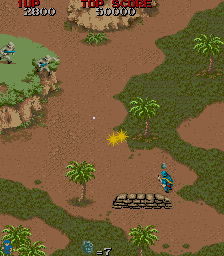










Making her idol debut well before THE iDOLM@STER and even Idol Hakkenden, Athena Asamiya is one of the very first video game idol characters. Unless Yohko Ishino counts, and let's face it, she doesn't. As the purple-haired, psychic-powered, J-Pop singing descendant of the old Goddess of Wisdom Athena, she's not that fleshed-out here, but her later appearances in The King of Fighters series would add a bit more to her character (as well as changing her voice and costume every year). For now, she's just one of two final hopes for the Earth against the evil Shiguma hordes. Putting the fate of the planet in the hands of an idol... What savage times the '80s were.
| 
Oh, poor Kensou. They couldn't even decide how to translate his name at this point, it's spelled Kensu in this game and Kensou in his later reappearances in The King of Fighters. Kensou is the man who never wins- you can't play as him without specifically starting a two-player game with two credits, he's kinda treated as a joke in The King of Fighters (has a bunch of goofy animations, loses his psychic powers at one point, has an unrequited Thing for Athena, isn't as broken as Chin in '96 is) and even in Psycho Soldier, there's bits here and there where he gets screwed over, as we will see. Poor guy. |
























![Ah yes, this is your ace in the hole.
[You're fired. - Ed]](images/psychos/psychos1up.gif)


